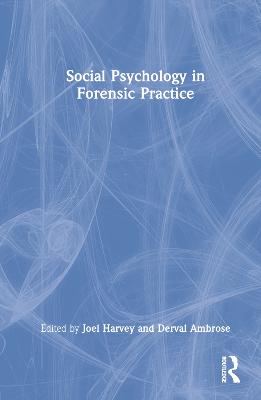Social Psychology in Forensic Practice
 -10%
portes grátis
-10%
portes grátis
Social Psychology in Forensic Practice
Ambrose, Derval; Harvey, Joel
Taylor & Francis Ltd
12/2022
252
Mole
Inglês
9781138676145
15 a 20 dias
Descrição não disponível.
Foreword
Rosie Meek
1. Introduction
Joel Harvey and Derval Ambrose
2. Attributions and Biases
Laura Bowden, Emily Glorney, and Emily Durber
3. Social Identity Theories
Deborah Morris and Elanor Webb
4. Impression Management
Joel Harvey and Deborah H. Drake
5. Attitudes and Beliefs
Lara Arsuffi
6. Aggression
Matt Bruce and Veronica Rosenberger
7. Group Formation and Behaviour
Derval Ambrose and Tania Tancred
8. Coercion and Social Influence
Vyv Huddy and Timothy A. Carey
9. Ostracism
Dennis Kaip and Joel Harvey
10. Stereotyping and Prejudice
Derval Ambrose, Colin Campbell and Dennis Kaip
Rosie Meek
1. Introduction
Joel Harvey and Derval Ambrose
2. Attributions and Biases
Laura Bowden, Emily Glorney, and Emily Durber
3. Social Identity Theories
Deborah Morris and Elanor Webb
4. Impression Management
Joel Harvey and Deborah H. Drake
5. Attitudes and Beliefs
Lara Arsuffi
6. Aggression
Matt Bruce and Veronica Rosenberger
7. Group Formation and Behaviour
Derval Ambrose and Tania Tancred
8. Coercion and Social Influence
Vyv Huddy and Timothy A. Carey
9. Ostracism
Dennis Kaip and Joel Harvey
10. Stereotyping and Prejudice
Derval Ambrose, Colin Campbell and Dennis Kaip
Este título pertence ao(s) assunto(s) indicados(s). Para ver outros títulos clique no assunto desejado.
risk assessment;formulations;interventions;multi-agency;offender;youth offending teams;probation;community health forensic services;criminal justice system;socio-forensic;self-discrepancy theory;self-presentation;social identity theory;categorisation theory;fundamental attribution error;actor-observer bias;self-serving attribution bias;negativity bias;cognitive load;availability heuristic;primacy and recency effects;personality disorder;social learning;mere exposure effect;cognitive dissonance;social ostracism;group socialisation;Group Formation;social facilitation;social inhibition;evaluation apprehension;social loafing;deindividuation;anti-social behaviour;ehabilitation;persuasion;social influence;radicalization;Stanford Prison Experiment;classic frustration-aggression hypothesis;displaced aggression;reflective practice;Broset Violence Checklist;Young Man;DASA;Good Lives Model;UK Prison;Forensic Clients;RNR Model;Forensic Practitioners;Forensic Mental Health Settings;Forensic Populations;Forensic Practice;Forensic Settings;Gender Role Strain;OPD Pathway;Social Psychological Lens;Hm Prison Service;Mental Health In-reach Team;Impression Management Subscale;Aggressive Incidents;CBT Approach;Dissonance Arousal
Foreword
Rosie Meek
1. Introduction
Joel Harvey and Derval Ambrose
2. Attributions and Biases
Laura Bowden, Emily Glorney, and Emily Durber
3. Social Identity Theories
Deborah Morris and Elanor Webb
4. Impression Management
Joel Harvey and Deborah H. Drake
5. Attitudes and Beliefs
Lara Arsuffi
6. Aggression
Matt Bruce and Veronica Rosenberger
7. Group Formation and Behaviour
Derval Ambrose and Tania Tancred
8. Coercion and Social Influence
Vyv Huddy and Timothy A. Carey
9. Ostracism
Dennis Kaip and Joel Harvey
10. Stereotyping and Prejudice
Derval Ambrose, Colin Campbell and Dennis Kaip
Rosie Meek
1. Introduction
Joel Harvey and Derval Ambrose
2. Attributions and Biases
Laura Bowden, Emily Glorney, and Emily Durber
3. Social Identity Theories
Deborah Morris and Elanor Webb
4. Impression Management
Joel Harvey and Deborah H. Drake
5. Attitudes and Beliefs
Lara Arsuffi
6. Aggression
Matt Bruce and Veronica Rosenberger
7. Group Formation and Behaviour
Derval Ambrose and Tania Tancred
8. Coercion and Social Influence
Vyv Huddy and Timothy A. Carey
9. Ostracism
Dennis Kaip and Joel Harvey
10. Stereotyping and Prejudice
Derval Ambrose, Colin Campbell and Dennis Kaip
Este título pertence ao(s) assunto(s) indicados(s). Para ver outros títulos clique no assunto desejado.
risk assessment;formulations;interventions;multi-agency;offender;youth offending teams;probation;community health forensic services;criminal justice system;socio-forensic;self-discrepancy theory;self-presentation;social identity theory;categorisation theory;fundamental attribution error;actor-observer bias;self-serving attribution bias;negativity bias;cognitive load;availability heuristic;primacy and recency effects;personality disorder;social learning;mere exposure effect;cognitive dissonance;social ostracism;group socialisation;Group Formation;social facilitation;social inhibition;evaluation apprehension;social loafing;deindividuation;anti-social behaviour;ehabilitation;persuasion;social influence;radicalization;Stanford Prison Experiment;classic frustration-aggression hypothesis;displaced aggression;reflective practice;Broset Violence Checklist;Young Man;DASA;Good Lives Model;UK Prison;Forensic Clients;RNR Model;Forensic Practitioners;Forensic Mental Health Settings;Forensic Populations;Forensic Practice;Forensic Settings;Gender Role Strain;OPD Pathway;Social Psychological Lens;Hm Prison Service;Mental Health In-reach Team;Impression Management Subscale;Aggressive Incidents;CBT Approach;Dissonance Arousal







